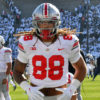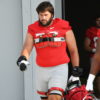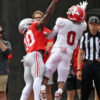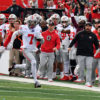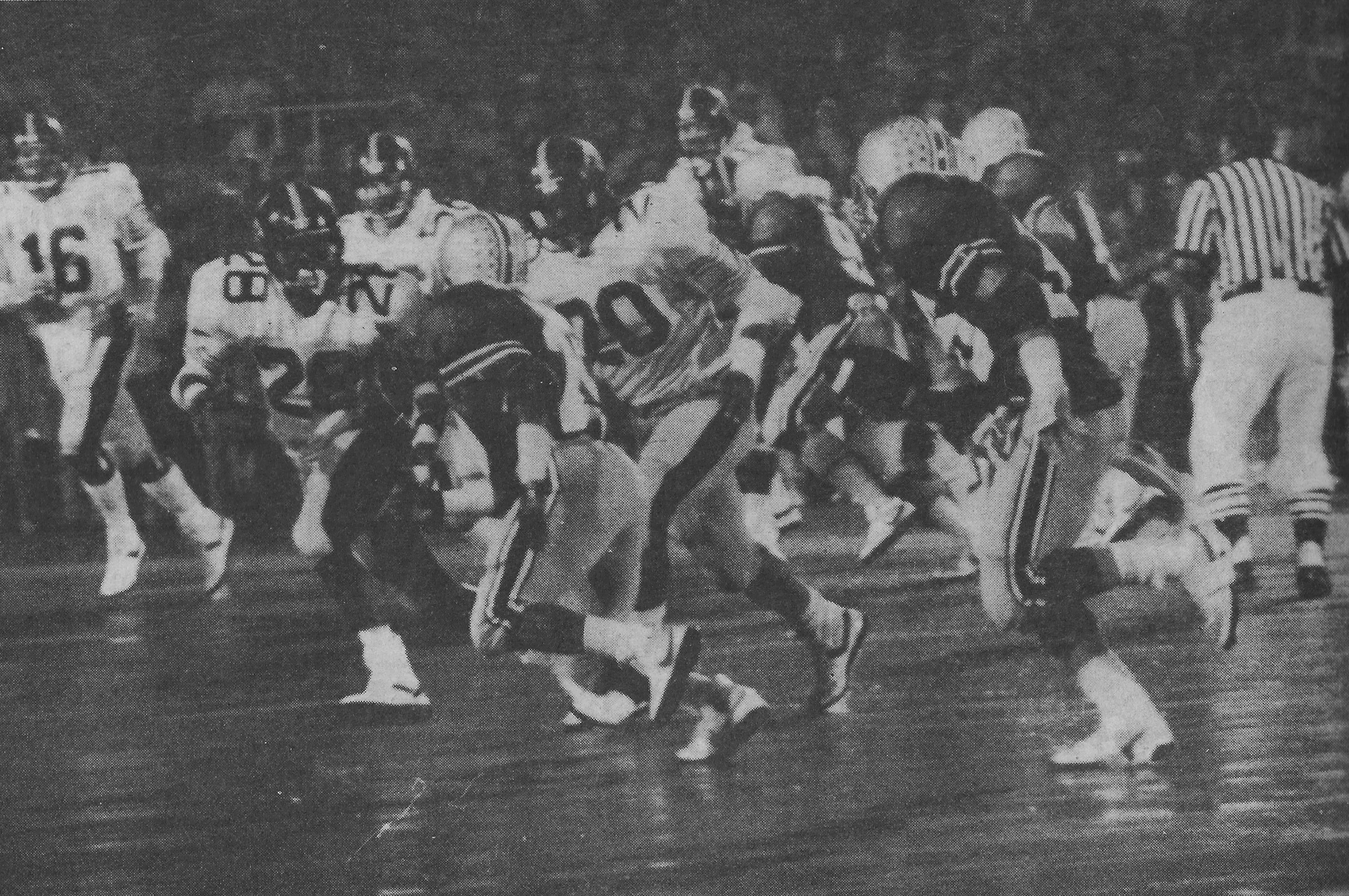
With the return of football up in the air, now serves as a perfect time for reflection on the history of football, and the strategic evolution of the game. To do that, the film study will be spending the offseason looking back at classic Ohio State games. Today’s film study revolves around Ohio State’s 1985 22-13 upset over then-No. 1 Iowa. There aren’t any Earle Bruce playbooks online, so we’re again stuck with the tape without a supplementary playbook. Video is from this cut-up. Last week’s film study can be found here.
Innovation in football is almost always driven by offense. The natural cycle of the sport dictates that an offensive coach will find a new way to exploit defenses, thrive for a few seasons, and then a defensive coach will adapt and innovate to answer and stop whatever the offensive innovation is. That process has been sped up massively in recent years with the proliferation of film readily available online, and the ability for coaches to work with their peers at any time, from anywhere in the country, through video conference technology, but the cycle does still exist.
In the older days of football, that cycle took much longer, and the phases of it were far more obvious. A new offense could thrive for a decade or more without a real response to it, as the T-formation, wishbone, I-formation and several others did in their heydays of the 50s, 60s, 70s and 80s. Even into the early 2000s, the rise of the spread offense didn’t garner a defensive response until late into the decade and well into the 2010s. The dominance phases of these offenses are easy to spot just from looking at team stats. Whenever there seems to be a sudden jump in points and yards for just a few teams, that means that those coaches found something new.
In the late 60s, as covered a few throwback film studies ago, that offense was the I-form, which teams like USC and eventually Ohio State rode to hundreds of wins, and in the case of the former, several national titles. The run heavy I-form was the go to formation, along with the wishbone through much of the 70s, with star running backs serving as the face of college football throughout the decade. In response, defenses trotted out the 5-2 front, and, eventually, were able to quell – or at least slow down – some of the nation’s most lethal rushing attacks.
Continuing the cycle, offenses evolved again. Grambling State under the legendary Eddie Robinson (it’s hard to overstate just how important HBCU football was in the development of modern football); Stanford under Bill Walsh; BYU under LaVell Edwards; California and Illinois under Mike White; Long Beach State and Dave Currey; Miami under Howard Schnellenberger and Jimmy Johnson and Iowa under Hayden Fry all had at least two things in common. Firstly, none of the schools were particularly special prior to the arrival of the coach that accompanied them.
Secondly, they all discovered at just about the same time that if your offense can move the ball 10, 20, 30, even 40 yards at a time through the air, it was going to make you a lot tougher to stop. With defenses deploying five defensive linemen to stop that rushing attack, and two big linebackers right behind them, there was plenty of space to air the ball out, and moving into the 80, teams like Miami and BYU found massive success exploiting defenses that had yet to react to the new spread out attack.
Iowa found that same success, thanks to both personnel and coaching staff. On the staff, head coach Hayden Fry and offensive coordinator Bill Snyder (yes, that Bill Snyder) worked to create an offense that could compete with the more talented teams in the conference like Ohio State and Michigan. In 1985, with quarterback Chuck Long, they did just that, throwing the ball nearly 35 times a game on the season on the way to a dominant 7-0 start that included a win over then-No. 2 Michigan to secure Iowa in the No. 1 spot heading into a Nov. 2 matchup with No. 8 Ohio State in Columbus.
The gameplan for the Hawkeyes against Ohio State was the same as it had been for the entire season, as they hoped to overwhelm the behemoth Buckeye defense with an aerial attack and speed that Ohio State’s defense – built for powerhouse football – wouldn’t be able to keep up with. It had worked against Michigan, and had turned Iowa into a threat in the Big Ten under Fry in the early 80s. While the big boys of the conference were grinding out wins, Iowa was looking to run right past them.
Unfortunately for Fry and the Hawkeyes, 1985 was just around the beginning of the next phase of the innovation cycle, which saw defenses begin to adapt to the new, dangerous passing attacks. The Buckeyes were part of that change, with first-year defensive coordinator Gary Blackney taking over the Silver Bullets and installing a defense that could stop both the run and the pass.
To simplify what that look consisted of, you could call it a 4-3, though it was far more flexible than the four down linemen, three linebacker structure that comes with the 4-3. It often took that form, but Blackney’s defense also offered a 3-4 front, as well as a 5-2 front, depending on what the situation called for. The key to all of it was in personnel rather than scheme, a significant shift from how defenses had worked for decades. Blackney took two defensive tackles, Fred Ridder and Daryl Lee, and surrounded them with five linebackers, all of whom could play as a traditional linebacker or move into more of an end role: Eric Kumerow, Chris Spielman, Larry Kolic, Pepper Johnson and Byron Lee.
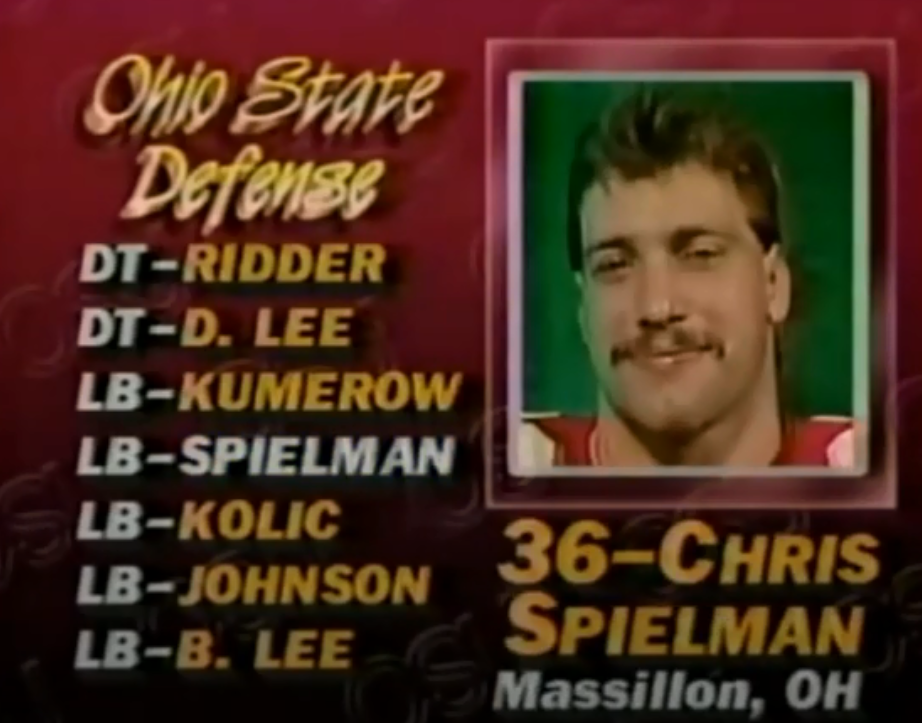
For much of the 1985 season, that new, flexible defense proved to be a little bit too malleable, shutting down Pitt in week one but allowing big games from Washington State (32 points), Illinois (31 points) and Purdue (27 points) on the way to a shaky but still very good 6-1 start. The early season struggles had even garnered criticism from OSU students and faculty. Spielman told reporters post game that he was tired of the criticism, both from his peers and fans.
“Students come up to me and say, ‘What’s wrong with the defense?’ ” Spielman said. “I go to eat lunch and the janitor asks ‘What’s wrong with the defense?’ ”
Ohio State’s defense had also been the topic of a column in the Citizen Journal that questioned if the Buckeyes would be able to hold Long under 1,000 yards on the day.
“I know that the article written in the Citizen Journal today – well, we took that a little bit to heart,” Spielman said. “All year we’ve been hearing criticism about our defense.
“I don’t care what people say about our defense. We’re 7-1, you know? I had a good feeling that we’d probably play the best defensive football game we’ve played. I think you could see how we run to the football, cause turnovers and make things happen.”
Spielman’s feeling entering the game was vindicated throughout the evening, in large part because of the innovations that Blackney had spent the year tinkering with. After being run past and passed all over by the trio of teams that combined for 90 points on the Buckeye defense, that ever-adapting five linebacker look finally paid dividends against the Hawkeyes, thanks in large part to the man in the middle of the defense: Spielman.
Spielman wasn’t alone in his efforts, despite the 19 next to him name in the total tackles column. Johnson matched his total, while corner Greg Rogan totaled 11. Those numbers, ultimately, didn’t tell the story, as it was the efforts of the defense as a group that worked to stun the Hawkeyes, with halfback Ronnie Harmon and Long unable to find much anything consistently all game, as a result of Ohio State’s ability to match whatever the situation suggested Snyder may look to dial up.
To start the game, in an obvious running situation, Ohio State was able to use those linebackers to load up the box and answer a toss play to the short side of the field. With five men on the line, Ohio State was able to match and neutralize Iowa’s four down blocking linemen and a tight end set to seal, leaving two free linebackers to track the halfback, with a pulling guard and fullback looking to stop them. Kumerow gets free of the tight end enough to take on the fullback, a defensive tackle works to drag that guard into the mud, leaving Harmon without any help on the outside, clearing an easy lane for Spielman to make the play.
This happens because Ohio State was able to match Iowa’s front without needing to change personnel. Those five linebackers could move freely and become essentially whatever Ohio State needed them to be.
Just a few plays later, in an obvious passing situation, Ohio State again shows a five man front, but just rushes Kumerow, Lee and Ridder, dropping everyone else into what looks to be a cover 4 shell. Long finds a slight opening in the defense but airmails the pass, despite almost no pressure in his face.
Long was flustered by this adjustable front all game long. It didn’t seem as though he knew how to handle a rush when he couldn’t read how many defenders he should be expecting prior to the play, which meant that even when Ohio State rushed three and dropped eight, he was afraid that pressure was going to be in his face right away, partially because many of his drops involved turning his back to the defense during the time when those linebackers were dropping from the front into coverage.
He sees it again here, with eight Buckeyes dropping into a zone behind three rushers. Even as he doesn’t turn his back to the defense on his drop, he just looks out of sorts with just three rushers coming. A tight end is open underneath, but Long – who had the fourth-best completion percentage of any quarterback in college football in 1985 (65.8 percent) – forgets how to throw completely and tosses a duck to Spielman because he’s in such a hurry to just get the ball out. Passing downs became a nightmare for the Hawkeyes, because Long never knew what he was going to see once the play started.
“I saw the tight end delaying,” Spielman said of this interception. “Chuck Long just overthrew him and I was just there to catch the ball. I (fumbled) it, but we got the ball. I tried to be a running back like in high school. That was two years ago. Sometimes I forget, and I have a flashback.”
To answer that, Iowa tried to flip the conventional play-calling wisdom, dialing up screen passes and draw plays on passing downs rather than chucking the ball down the field, hoping to catch Ohio State off guard with just a three-man front. That too was wrecked, this time not by scheme, but by Ohio State’s talent advantage, which Iowa’s offense was designed to overcome. As the Hawkeyes abandoned what was supposed to give them an edge, Ohio State was able to shift into a very comfortable place as a purely better team, winning by being stronger and bigger.
As the game continued on, things only got worse for Long. Without any real threat of a downfield pass as rain began to fall in Columbus, Ohio State gained more confidence in bringing extra pressure to add more trouble for Long to worry about.
He did not handle it well. Ohio State brings six rushers – three off the line with three delayed from the linebacker spot, while dropping five players into coverage. The pressure doesn’t get there, but it does move Long out of the pocket, where he forces a pass down the field. William White is stuck directly to the receiver’s hip in man coverage, jumps the pass, and forces the second of four Long interceptions on the day.
As the game moved forward, with Ohio State clutching to the lead entering the final 20 minutes, Iowa was forced to resort to power football. That rain had turned into a downpour, and Long, already troubled by the defense, was essentially unable to push the ball further than 10 yards down the field with the rain coming down.
Facing a crucial fourth-and short and looking to cut into the Buckeye lead in the third quarter, Iowa looked to just out gun the Buckeyes up front, loading the line of scrimmage with seven blockers, and setting Harmon behind two fullbacks in the backfield. To answer, Ohio State again flexed out that personnel, pushing four players to the line with two more just off the edge, while two linebackers and two safeties entered the box in anticipation for a run up the middle. The safety and two linebackers blitzed as the ball was snapped, and the Buckeyes were again able to stuff Iowa despite only two true defensive linemen being in on the play.
In the fourth quarter, after trading punts, Iowa was within nine with a minute and a half to play. The Hawkeyes were forced to take to the air to have any chance at completing a comeback, and again, it was Ohio State’s flexibility up front that confused Long and inevitably sealed the upset victory. Ohio State shows a five man front but rushed three, dropping eight into zone coverage. Long, with pressure coming off of the edge, looks to force a pass across the middle, hoping to drop it in just behind the linebackers but underneath the defensive backfield.
Instead, Spielman snatches the ball out of the air for his second interception, and individual effort that, while outstanding, probably wasn’t even necessary, as Johnson was right behind him in coverage, positioned to catch the pass had Spielman mistimed his jump. It was a fitting end to a nightmarish performance for Long, and a perfect encapsulation of what Ohio State had done defensively all game. Long was flustered and forced a pass into a defense that was working perfectly as a unit. With no room to throw, it was really only a matter of which Buckeye would come down with it.
“You saw a great effort out there today,” Bruce said after the game. “The defense kind of came back and did a great job. An outstanding job, intercepting the ball four times and forcing a fumble. They swarmed to the football and played well.
“We played as hard as we’ve played at Ohio Stadium in a long time and against the No. 1 team. It was a great team victory for us… One of the great victories I’ve ever been associated with as a coach.”
For four free issues of the now-monthly print edition of Buckeye Sports Bulletin, no card required, sign up at the link here: https://www.buckeyesports.com/subscribe-4issue-trial/



